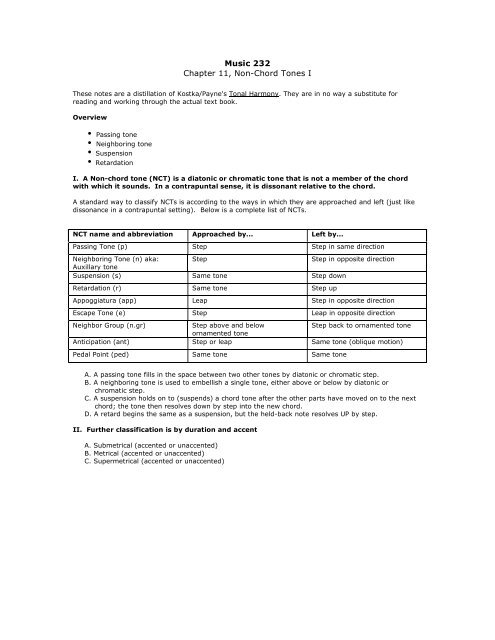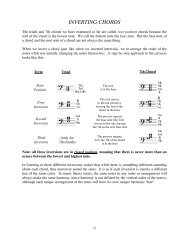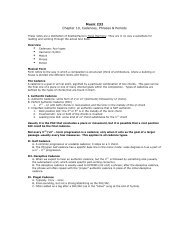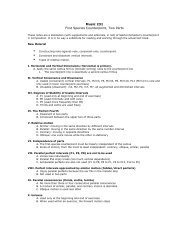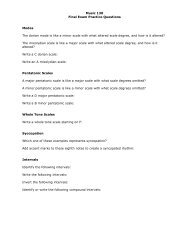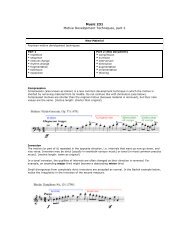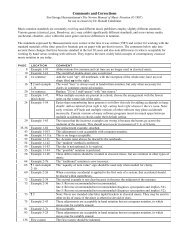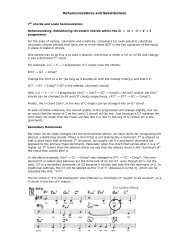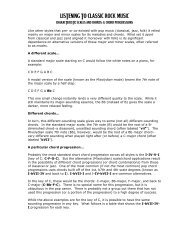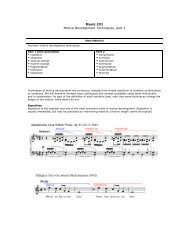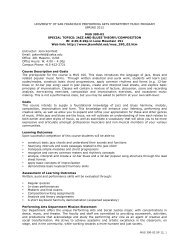Music 232 Chapter 11, Non-Chord Tones I - Jkornfeld.net
Music 232 Chapter 11, Non-Chord Tones I - Jkornfeld.net
Music 232 Chapter 11, Non-Chord Tones I - Jkornfeld.net
Create successful ePaper yourself
Turn your PDF publications into a flip-book with our unique Google optimized e-Paper software.
<strong>Music</strong> <strong>232</strong><strong>Chapter</strong> <strong>11</strong>, <strong>Non</strong>-<strong>Chord</strong> <strong>Tones</strong> IThese notes are a distillation of Kostka/Payne's Tonal Harmony. They are in no way a substitute forreading and working through the actual text book.Overview• Passing tone• Neighboring tone• Suspension• RetardationI. A <strong>Non</strong>-chord tone (NCT) is a diatonic or chromatic tone that is not a member of the chordwith which it sounds. In a contrapuntal sense, it is dissonant relative to the chord.A standard way to classify NCTs is according to the ways in which they are approached and left (just likedissonance in a contrapuntal setting). Below is a complete list of NCTs.NCT name and abbreviation Approached by... Left by...Passing Tone (p) Step Step in same directionNeighboring Tone (n) aka:StepStep in opposite directionAuxillary toneSuspension (s) Same tone Step downRetardation (r) Same tone Step upAppoggiatura (app) Leap Step in opposite directionEscape Tone (e) Step Leap in opposite directionNeighbor Group (n.gr)Step above and belowStep back to ornamented toneornamented toneAnticipation (ant) Step or leap Same tone (oblique motion)Pedal Point (ped) Same tone Same toneA. A passing tone fills in the space between two other tones by diatonic or chromatic step.B. A neighboring tone is used to embellish a single tone, either above or below by diatonic orchromatic step.C. A suspension holds on to (suspends) a chord tone after the other parts have moved on to the nextchord; the tone then resolves down by step into the new chord.D. A retard begins the same as a suspension, but the held-back note resolves UP by step.II. Further classification is by duration and accentA. Submetrical (accented or unaccented)B. Metrical (accented or unaccented)C. Supermetrical (accented or unaccented)
III. Figured bass analysis of suspensionsSuspensionFigured bass symbol9-8 9 87-6 7 6 or 7 63 -4-3 4 3 or 4 # (or natural symbol)2-3 52under first bass note6 under the nextIV. Lead sheet symbolsA. The traditional 4-3 suspension is indicated by "sus", such as C7sus (spelled C, F, G, Bb).B. The suspended 4 th , however, may not resolve down to the 3 rd of the chord.C. There are alternative symbols, such as "sus 4" or "sus <strong>11</strong>", but they are not referred to in this text.


